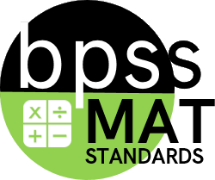BPS District Mathematics Standards Book
Math Learning Progressions
[S] Statistics and Probability
Math Learning Progressions HS Math Concepts
[S] Statistics and Probability
Students’ prior knowledge includes:
- Students investigate patterns of association in bivariate data (grade 8)
- Students use random sampling to draw inferences about a population (grade 7)
- Students draw informal comparative inferences about two populations (grade 7)
- Students investigate chance processes and develop, use, and evaluate probability models (grade 7)
- Students develop an understanding of statistical variability (grade 6)
- Students summarize and describe distributions (grade 6)
Interpreting Categorical and Quantitative Data
- Summarize, represent, and interpret data on a single count or measurement variable.
- Summarize, represent, and interpret data on two categorical and quantitative variables.
- Interpret linear models.
Making Inferences and Justifying Conclusions
- Understand and evaluate random processes underlying statistical experiments.
- Make inferences and justify conclusions from sample surveys, experiments and observational studies.
Conditional Probability and the Rules of Probability
- Understand independence and conditional probability and use them to interpret data.
- Use the rules of probability to compute probabilities of compound events in a uniform probability model.
Using Probability to Make Decisions
- Calculate expected values and use them to solve problems.
- Use probability to evaluate outcomes of decisions.
MAT-HS.S [S] Overview: Statistics and Probability
MAT-HS.S-ID Domain: [S-ID] Interpreting Categorical and Quantitative Data
-
- MAT-HS.S-ID.01 Represent data with plots on the real number line
- MAT-HS.S-ID.02 Use statistics to compare center and spread of two or more data sets
- MAT-HS.S-ID.03 Interpret differences in shape/center/spread of data, accounting for outliers
- MAT-HS.S-ID.04 Use the mean and standard deviation of a data set for normal distribution
- MAT-HS.S-ID.05 Summarize categorical data for two categories in twoway frequency tables
- MAT-HS.S-ID.06 Represent data on two quantitative variables on a scatter plot
- S-ID.06.a Fit a function to the data to solve problems
- S-ID.06.b Informally assess the fit of a function by plotting and analyzing residuals
- S-ID.06.c Fit a linear function for a scatter plot that suggests a linear association
- MAT-HS.S-ID.07 interpret the Slope and the Intercept of a linear model in context of data
- MAT-HS.S-ID.08 Compute and interpret the correlation coefficient of a linear fit
- MAT-HS.S-ID.09 Distinguish between correlation and causation
MAT-HS.S-IC Domain: [S-IC] Making Inferences and Justifying Conclusions
-
- MAT-HS.S-IC.01 Understand statistics as a process for making inferences based on random sample
- MAT-HS.S-IC.02 Decide if a model is consistent with results from a data-generating process
- MAT-HS.S-IC.03 Compare the purposes of surveys/experiments/observational studies
- MAT-HS.S-IC.04 Use data from a sample survey to estimate a population mean or proportion
- MAT-HS.S-IC.05 Use data from a randomized experiment to compare two treatments
- MAT-HS.S-IC.06 Evaluate reports based on data
MAT-HS.S-CP Domain: [S-CP] Conditional Probability and the Rules of Probability
-
- MAT-HS.S-CP.01 Describe events as subsets of a sample space using characteristics
- MAT-HS.S-CP.02 Using probabilities, understand and show that two events are independent
- MAT-HS.S-CP.03 Understand the conditional probability of A given B as P(A and B)/P(B
- MAT-HS.S-CP.04 Construct and interpret two-way frequency tables of data
- MAT-HS.S-CP.05 Recognize and explain the concepts of conditional probability and independence
- MAT-HS.S-CP.06 Find the probability of A given B as the fraction of B??s outcomes belong to A
- MAT-HS.S-CP.07 Apply and interpret the Addition Rule of probability
- MAT-HS.S-CP.08 Apply the general Multiplication Rule in a uniform probability model
- MAT-HS.S-CP.09 Use permutations and combinations to compute probabilities
MAT-HS.S-MD Domain: [S-MD] Using Probability to Make Decisions
-
- MAT-HS.S-MD.01 Define a random variable for a quantity of interest by assigning a numerica
- MAT-HS.S-MD.02 Calculate the expected value of a random variable; interpret it as the mean
- MAT-HS.S-MD.03 Develop a probability distribution for a random variable defined for a samp
- MAT-HS.S-MD.04 Develop a probability distribution for a random variable defined for a samp
- MAT-HS.S-MD.05 Weigh outcomes of a decision by assigning probabilities to payoff values
- S-MD.05.a Find the expected payoff for a game of chance
- S-MD.05.b Evaluate and compare strategies on the basis of expected values
- MAT-HS.S-MD.06 Use probabilities to make fair decisions
- MAT-HS.S-MD.07 Analyze decisions and strategies using probability concepts
A Sample of HS Math Concept Statistics and Probability your child will be learning
Interpreting Categorical and Quantitative Data
- Summarize, represent, and interpret data on a single count or measurement variable.
- Summarize, represent, and interpret data on two categorical and quantitative variables.
- Interpret linear models.
Making Inferences and Justifying Conclusions
- Understand and evaluate random processes underlying statistical experiments.
- Make inferences and justify conclusions from sample surveys, experiments and observational studies.
Conditional Probability and the Rules of Probability
- Understand independence and conditional probability and use them to interpret data.
- Use the rules of probability to compute probabilities of compound events in a uniform probability model.
Using Probability to Make Decisions
- Calculate expected values and use them to solve problems.
- Use probability to evaluate outcomes of decisions.
